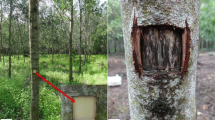Abstract
The resistance of cacao (Theobroma cacao. L)leaves to 10 isolates of Phytophthora palmivora(Butler) Butler was investigated in 18 genotypes of cacao in three experiments. Tissue-paper-mount and punch-inoculation methods were used to distinguish between resistance at the penetration and post-penetration levels based on lesion frequency and size, respectively. There was a 5–6 fold difference in aggressiveness among isolates collected from different locations in the islands of Trinidad and Tobago for both types of resistance. However, host genotype ×isolate interaction effects were not significant for resistance at both the penetration and post-penetration levels. A strong positive relationship (r = 0.8) was observed in the abilities of isolates to effectively breach the two types of resistance. This suggests that the same isolate can be used in screening for both types of resistance. No significant relationship was found between resistance at the penetration and post-penetration levels suggesting that the resistance mechanisms were different. Subsequent experiments using a wider range of cacao genotypes from the International Germplasm Collection, Trinidad, confirmed the initial results. These experiments indicate that resistance found using one isolate would be equally valid using other isolates of Phytophthora palmivora. The implications of the findings are discussed.
Similar content being viewed by others
References
Agrios, G.N., 1988. Plant Pathology. 3rd ed. San Diego, California: Academic Press Inc.
Akinrefon, O.A., 1971. Phenolic fungitoxicity and the possible role of phenolase of P. palmivora (Butl) Butl Phytopath Z 63: 153–154.
Amponsah, J.D., 1988. Studies on field resistance of cocoa varieties to P. palmivora (Butl.)Butl. infection. In: Proc. 10th Int. Cocoa Res. Conf. Santo Domingo, Dominican Republic, 17–23 May 1987: 557–567.
Asomaning, E.J.A., 1972. Cocoa research in Ghana. Cocoa Growers Bull 19: 13–18.
Chowdappa, P. & R. Chandra Mohananan, 1993. Pathogenic variability among isolates of Phytophthora capsici causing black pod disease of cocoa in India. In: Proc. 11th Int. Cocoa Res. Conf. Côte d'Ivoire, 18–24 July 1993. Cocoa Producers Alliance. 135–143.
Fagan, H.J., 1984. An assessment of pathological research on cocoa in Jamaica from1950–1980 and current research priorities. Trop Pest Manage 30: 430–439.
Greathouse, D.C., W.M. Laetsh & B.O. Phinney, 1971. The shoot growth rhythm of a tropical tree (Theobroma cacao L.). Am J Bot 58: 281–286.
Iwaro, A.D., T.N. Sreenivasan & P. Umaharan, 1993. Relationship between leaf and pod resistance in cocoa toP. palmivora infection. Ann. Rep. Cocoa Res. Unit, University of the West Indies, Trinidad and Tobago. pp. 33–39.
Iwaro, A.D., T.N. Sreenivasan & P. Umaharan, 1997a. Foliar resistance to Phytophthora palmivora as an indicator ofpod resistance in Theobroma cacao. Plant Disease 81: 619–624.
Iwaro, A.D., P. Umaharan & T.N. Sreenivasan, 1997b. Inheritance of foliar resistance to Phytophthora palmivora (Butler) Butler. in cacao (Theobroma cacao L.). Euphytica 96: 377–383.
Iwaro, A.D., T.N. Sreenivasan & P. Umaharan, 1998. Cacaoresistance to Phytophthora: Effect of pathogen species, inoculation depths and pod maturity. Eur J Plant Pathol 104: 11–15.
Lawrence, J.S., 1978. Evaluation of methods for assessing resistance to cacao cultivars, and hybrids to P. palmivora.Bol Tec 62, CEPLAC, CEPEL, Itabuna, Brazil.
Manco, G.R. 1974. Blight of shoots, chupons, cuttings,grafts, and seedlings. In: P.H. Gregory (Ed.), Phytophthora Diseases of Cocoa, pp. 149–152. Longman, London.
Nyassé, S., C. Cilas, C. Herail & G. Blaha, 1995. Leaf inoculation as an early screening test for cocoa (Theobromacacao L.) resistance to Phytophthora black pod disease, Crop protection 14: 657–663.
Opeke, L.K. & A.M. Gorenz, 1974. Phytophthora pod rot; symptoms and economic importance. In: P.H. Gregory (Ed.), Phytophthora Disease of Cocoa, pp. 117–124. Longman, London.
Orellana, R.G., 1959. Variation inPhytophthora palmivora isolates from cacao and rubber. Phytopathology 49: 210–213.
Prior, C., 1981.Phytophthora bark canker of cocoa in Papua New Guinea. In: Proc. 7th Int. Cocoa Res. Conf. Douala, Cameroon, 5–12 Nov, 1979, pp. 272–275.
Ram, C. & A. Ram, 1973. Virulence of some selected isolates of Phytophthora palmivora in cocoa. Revista Theobroma 3: 12–16.
Rocha, H.M., 1974. Breeding cacao for resistance to P. palmivora.In: P.H. Gregory (Ed.), Phytophthora Disease of Cocoa, pp. 211–218. Longman, London.
Simmonds, N.W.,1994. Horizontal resistance to cocoa diseases. Cocoa Growers Bull 47: 42–53.
Soria, V.J., 1974.Sources of resistance to Phytophthora palmivora. In: P.H. Gregory (Ed.), Phytophthora Disease of Cocoa, 197–202. Longman, London.
Spence, J.A., 1961. Black pod disease of cocoa. A comparison of isolates of Phytophthorapalmivora (Butl.) Butl. Ann Appl Biol 49: 717–722.
Tan, G.Y. & W.K. Tan, 1990. Additiveinheritance of resistance to pod rot caused by Phytophthora palmivora in cocoa. Theor Appl Genet 80: 258–264.
Thorold, C.A., 1975. Diseases of Cocoa. Clarendon press, Oxford.
Turner, P.D., 1965. Comparativesporulation as an indication of resistance by cacao to Phytophthora pod rot. Tropical Agriculture Trinidad 42: 305–309.
Vanderplank, J.E., 1982. Host-Pathogen Interactions in Plant Disease. Academic Press, New York.
Van derVossen, H.A.M., 1997. Strategies of variety improvement in cocoa with emphasis on durable disease resistance: An external review prepared for INGENIC. International Group for Genetic Improvement of Cocoa (INGENIC). pp 32.
Wood, G.A.R. & R.A. Lass, 1985. Cocoa. 4th ed. Longman Singapore Publishers (Ptc) Ltd. 11: 267–282
Zentmyer, G.A., 1972. Variation in Phytophthora palmivora. In: Proc. 4th Int Cocoa Res Conf Trinidad andTobago January, 1972. pp 471–472.
Zentmyer, G.A., 1988. Taxonomic relationships and distribution of species ofPhytophthora causing black pod of cacao. In: Proc. 10th Int. Cocoa Res. Conf. Santo Domingo, Dominican Republic, 17–23 May, 1987. 391–395.
Author information
Authors and Affiliations
Rights and permissions
About this article
Cite this article
Surujdeo-Maharaj, S., Umaharan, P. & Iwaro, A. A study of genotype-isolate interaction in cacao (Theobroma cacao L.): resistance of cacao genotypes to isolates of Phytophthora palmivora . Euphytica 118, 295–303 (2001). https://doi.org/10.1023/A:1017516217662
Issue Date:
DOI: https://doi.org/10.1023/A:1017516217662




